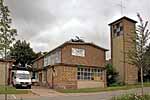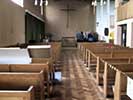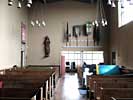Clifton St FrancisArchaeology
 View of the church from View of the church from
the north |
The church was built on a greenfield site with no previous structure there apart from the workman’s hut used for services before the church was completed. It was built of light coloured bricks and concrete blocks on a steel framework with a shallow pitched roof covered with ruberoid felt. It consisted of nave, chancel, anteroom leading to the hall, tower, choir or side chapel and clergy vestries, organ loft, store room, kitchen and toilets. Projecting blue bricks were used for decoration on the outer walls of the tower and hall. All interior walls were plastered. The roof of the hall was re-felted in 2005.
The main windows facing the street had been replaced with PVCU white finish. In 2007 it was reported that there was much damage to the steelwork and metal windows. All the aluminium supporting brackets for the louvres in the tower had corroded badly and were removed along with all the louvres, which were replaced with ‘Galebreaker’ material to the six openings. Due to vandalism several vulnerable windows were removed and the spaces blocked up with red bricks.
 The nave looking east The nave looking east |
 The nave looking west The nave looking west |
Parts of the nave ceiling and that of the hall and corridor to the hall were covered by panels attached to timber joists. At least two of the panels in the nave were, in 2013, in a bad state due to water damage.
There were various floor coverings. In the nave wood block parquet was used, but in the sanctuary it was Portland Purbeck freestone, which by 1973 was badly pitted. The corridor to the hall had quarry tile flooring, but in the office and entrance area thermoplastic tiles and carpet sufficed. The Hope Church put new carpet down in the hall and decorative wall panels.
The modern brick vicarage was built next to the church on Southchurch Drive. Known as St. Francis House, it contains seven rooms downstairs and eight upstairs. Gardens back and front are 28 yards (25.6 m) long.
The chapel was to be called St. Clare’s Chapel. But it was too cold for services so the clergy vestry was converted into a chapel and the choir moved to a small room near the kitchen. The old choir vestry became the clergy vestry.
Technical Summary
Compiled prior to demolition.
Timbers and roofs
|
NAVE |
CHANCEL |
TOWER |
| Main |
False ceiling plaster panels conceal the superstructure. |
Identical with and contiguous to nave. |
|
| S.Aisle |
n/a |
|
|
| N.Aisle |
n/a |
|
|
| Other principal |
|
|
|
| Other timbers |
|
|
|
Bellframe
The bellframe was by Hayward Mills dated 2007, steel, Pickford group 8.2.A.
Not scheduled for preservation.
Walls
|
NAVE |
CHANCEL |
TOWER |
| Plaster covering & date |
Plastered and painted |
Plastered and painted |
|
| Potential for wall paintings |
None |
None |
|
Excavations and potential for survival of below-ground archaeology
There have been no known archaeological excavations.
The main fabric dated entirely from 1953-7. The previous use for the site was agricultural fields.
The churchyard was roughly square, with the church positioned centrally. There were no burials.
The overall potential for the survival of below-ground archaeology in the churchyard, is considered to be LOW, dating entirely from 1953 and later. The potential for pre-church archaeological deposits is UNKNOWN but likely to be LOW. Below the former interior floors of the church it is considered to be LOW. The fabric of the church was all 1953-7 and the potential for archaeology in the standing fabric of the post-modern period (by Vernon Royle) was considered to be MODERATE.
Exterior: No burials. Minimal landscaping. Pre-church archaeology unknown.
Interior: Stratigraphy under the church is likely to be all 1953-7 construction evidence.
|